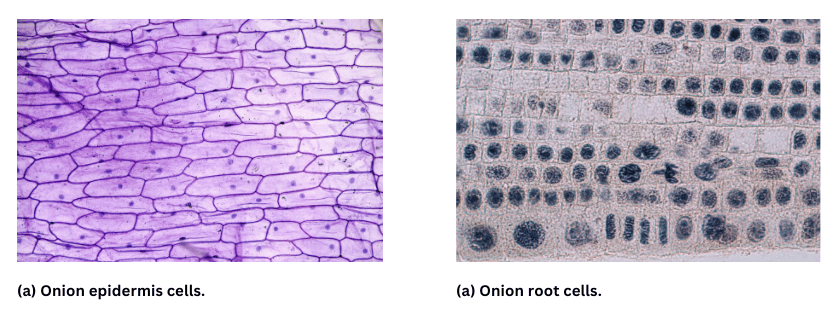2. Complete Activity 5.2 (Page 50).
• We can try preparing temporary mounts of leaf peels, tip of roots of onion or even peels of onions of different sizes.
• After performing the above activity, let us see what the answers to the following questions would be:
(a) Do all cells look alike in terms of shape and size?
(b) Do all cells look alike in structure?
(c) Could we find differences among cells from different parts of a plant body?
(d) What similarities could we find?
Answer:
Aim: To observe the temporary mounts of leaf peels, tip of roots of onion or even peels of onions under the microscope, compare the observations and conclude.
Materials Required: Onion bulb, onion leaf, onion root, forceps, watch-glass, water, glass slide, water, camel hair paintbrush, safranin solution, cover slip, mounting needle, compound microscope.
Procedure:
(i) Using the pairs of forceps, the epidermis from the concave side of the onion is peeled off.
(ii) The layer is put immediately in a watch-glass containing water to prevent folding and drying of the peel.
(iii) Now a glass slide is taken and a drop of water is put on it.
(iv) A small piece of the peel is transferred from the watch-glass to the slide using the thin camel hair paintbrush, making sure that the peel is perfectly flat on the slide.
(v) A drop of safranin solution is put on the piece.
(vi) Then a cover slip is put on it with the help of a mounting needle, taking care to avoid air bubbles. This can be done under teacher supervision.
(vii) Now the slide is observed under low power followed by high powers of a compound microscope. The observations are noted.
(viii)Similarly, temporary mounts leaf peels and tip of roots of onion are prepared and observed under the compound microscope.
(ix) The observations in the three cases are compared.
Observations:
- The cells are different in terms of shape and size.
- The cells look different in structure.
- Yes, we can find differences among cells from different parts of a plant body.
- The cells were similar in that contain a cell wall, cell membrane, cytoplasm, and nucleus.

Conclusions:
- Depending on their location and function within the plant, cells can vary significantly in shape and size.
- Different types of cells have distinct structures. For example, leaf cells contain chloroplasts, while root cells may have specialized structures for absorption of water and nutrients from the soil.
- The cells from different parts of the plant are different in shape, size and structure.
- All plants cells are similar in that they all contain a cell wall, cell membrane, cytoplasm, and nucleus.
“• We can try preparing temporary mounts of leaf peels, tip of roots of onion or even peels of onions of different sizes.
• After performing the above activity, let us see what the answers to the following questions would be:
(a) Do all cells look alike in terms of shape and size?
(b) Do all cells look alike in structure?
(c) Could we find differences among cells from different parts of a plant body?
(d) What similarities could we find?” – Solved.
Related Links:
Solution to Activity 5.1
Solution to Activity 5.2
Solution to Activity 5.3
Solution to Activity 5.4
Solution to Activity 5.5
Solution to Activity 5.6
Solution to Activity 5.7
Solution to Chapter 5 The Fundamental Unit of Life


